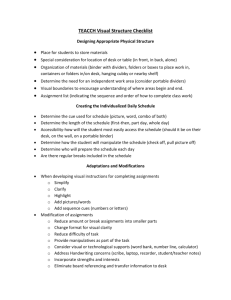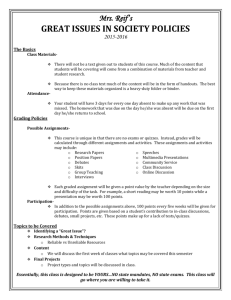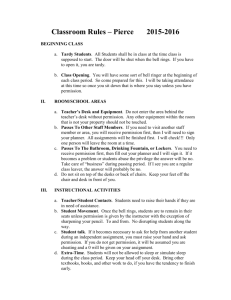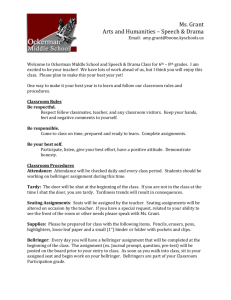Home Learning KS3
advertisement
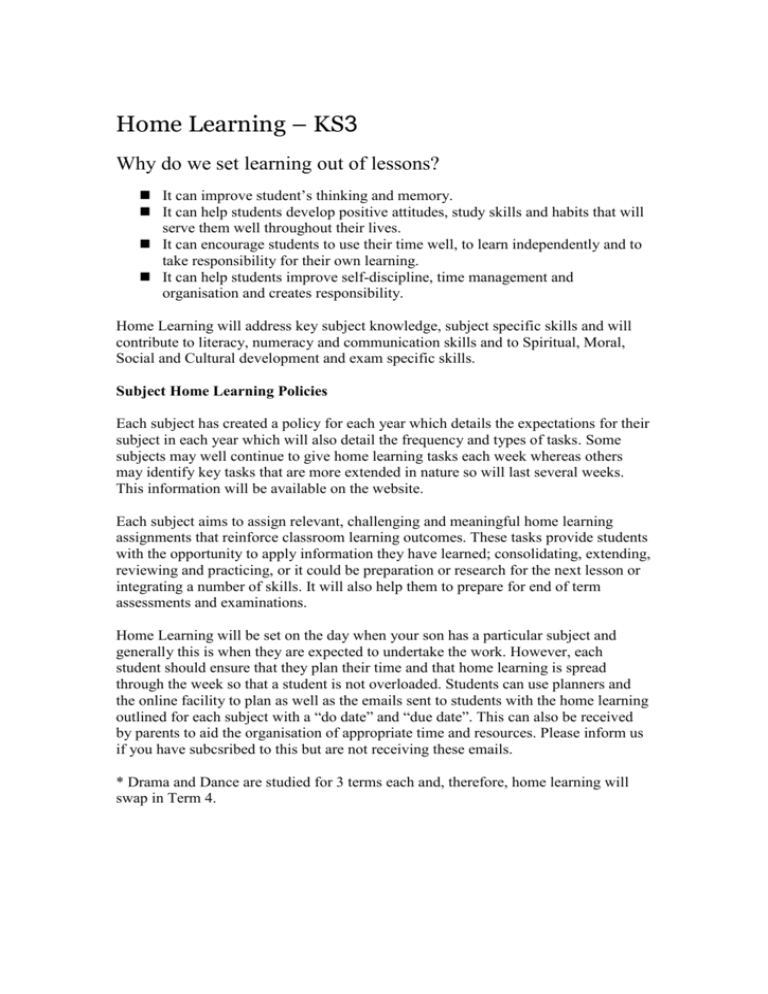
Home Learning – KS3 Why do we set learning out of lessons? It can improve student’s thinking and memory. It can help students develop positive attitudes, study skills and habits that will serve them well throughout their lives. It can encourage students to use their time well, to learn independently and to take responsibility for their own learning. It can help students improve self-discipline, time management and organisation and creates responsibility. Home Learning will address key subject knowledge, subject specific skills and will contribute to literacy, numeracy and communication skills and to Spiritual, Moral, Social and Cultural development and exam specific skills. Subject Home Learning Policies Each subject has created a policy for each year which details the expectations for their subject in each year which will also detail the frequency and types of tasks. Some subjects may well continue to give home learning tasks each week whereas others may identify key tasks that are more extended in nature so will last several weeks. This information will be available on the website. Each subject aims to assign relevant, challenging and meaningful home learning assignments that reinforce classroom learning outcomes. These tasks provide students with the opportunity to apply information they have learned; consolidating, extending, reviewing and practicing, or it could be preparation or research for the next lesson or integrating a number of skills. It will also help them to prepare for end of term assessments and examinations. Home Learning will be set on the day when your son has a particular subject and generally this is when they are expected to undertake the work. However, each student should ensure that they plan their time and that home learning is spread through the week so that a student is not overloaded. Students can use planners and the online facility to plan as well as the emails sent to students with the home learning outlined for each subject with a “do date” and “due date”. This can also be received by parents to aid the organisation of appropriate time and resources. Please inform us if you have subcsribed to this but are not receiving these emails. * Drama and Dance are studied for 3 terms each and, therefore, home learning will swap in Term 4. Ways Parents Can Help With Home Learning Ask your child daily about home learning and check your emails and/or online. This shows your child you are invested in his academic success, but also gives you a chance to provide help, for example, planning out a schedule for approaching a long-term project. Planning Pupils can often feel overwhelmed when they look over their list of assignments for the week. Help your child manage his assignments by using their daily planner. This can be particularly helpful with ongoing project based work. Writing down what needs to be done can be a great way to manage home learning, and crossing off assignments when they are completed and tracking their own progress can be satisfying for pupils and helps give them motivation to continue their work. Talk to the subject teacher If your child is struggling or spending too much time on tasks they may need some extra help or a specialised home learning plan that reduces the amount of home learning or which might include attendance at a home learning club. By working together, you and your child’s teacher can find ways to identify and handle any problems that may be creating stress for your child. After-School Activities If your child has an after-school activity every day and is struggling to manage their workload, it may be time to create a weekly timetable of when home learning can be completed – perhaps over the weekend to avoid overload. Get into a Regular Routine Everyone is different but if your child tends to focus better if they go right into work after school, then let them get right to work as soon as they get home or they might work better after having something to eat. The important thing is to find what works and create a regular routine. If your child knows what is expected and when, it will be easier for them to work more efficiently. Structuring the home learning tasks If your child finds a particular subject or topic hard encourage them to look at that first when they are still fresh and then move onto things they find easier or more enjoyable. Supervise, discuss and encourage but do not create your child's project! The point of a project is to teach students to plan, organise and present information all by themselves, not to have the best or most attractive finished product. It is okay to help come up with ideas and to buy supplies, but resist the urge to step in. Do not do their work - simply be there for your child. Look over completed home learning tasks. The purpose is not only to make sure they has actually done it, but also to make sure it has been done well with excellent presentation. Some children rush through assignments and make careless mistakes, while others may misunderstand the directions and do the assignment completely wrong. These are things a quick check can help to catch. Make Home Learning Fun Students are more likely to view home learning as less of a chore if you help them adopt a more playful attitude toward their work. Be sure to check work everyday, and try to make that a fun routine as well. Challenge your child to find mistakes in the work to see if they can spot any errors. If you take a relaxed approach and adopt a fun attitude about it, your child will follow suit. Tie-in Home Learning to Everyday Life Learning can often be more fun when young people are able to relate the material to things in their own lives. For instance, if your child has to read about immigrants and answer questions about them, continue the discussion over dinner or in the car. Talk about your own family’s immigrant experience (“Great-Grandma came from Italy and had to work very hard” or some such) or talk about the ways our world has been shaped by immigrants (“What would life be like today without pizza?”). By making home learning something that is an extension of learning and life, you can help your child see that it is not some separate chore or extra work that they are forced to do. Work Along side Your Child Younger children tend to work better when an adult is nearby, ready to answer questions or help work out a problem. You can sit down with your own work or a magazine article or bills while your child does their assignment or an older sibling, who is also working, may act as a support. Schedule Breaks It is important to stretch their legs or take a break for a few minutes to help concentration and improve mood. Studies have shown that physical activity can help stimulate concentration and cognitive function. As students mature parents should play a supportive role through monitoring completion of assignments, encouraging students’ efforts, and providing a conducive environment for learning. Home Learning Clubs Home Learning Zone is available every lunchtime 1 -1.50 and after school 3.35 - 4.30 each day in D5. Individual subjects may offer lunch or after school sessions where individuals can go to do their work and access support. Students should check the extra-curricular timetable and check with their teacher. A list of these will be put on the website and students made aware of them. Setting up a space Where you set up the home learning area in your home is not as important as the fact that you have some kind of designated place where your child has the comfort and quiet to relax and concentrate. Younger pupils generally need more supervision and help so you may want to consider setting up an area for him at the dining room table, even if he has a desk and chair in his room. That way, you can tackle other tasks while you help. Ask him to help you set up the work area. Letting him have a say in how his workspace is arranged will make it more likely that he will want to do work there. It will also help make home learning seem more fun. Which chair will he want to sit in? How about a footstool so that his legs don’t dangle and he can sit comfortably? Giving him the power to make small decisions will have a big impact on how much he’ll be motivated. Have supplies on hand. Put pens, markers, pencils and other art and school supplies your child will need in a portable bin so that he will have everything within easy reach. Hunting around for supplies will take his attention away from the task at hand and wastes time. Turn off the TV. Keep noise and distractions to a minimum so that your child can focus on his work. Ask family members to respect home learning time by not having phone conversations nearby or by doing quiet activities themselves, such as reading. Let there be light. Make sure his workspace is well-lit so that he can see comfortably. Cut out the clutter. You know how tough it can be to concentrate when you’re surrounded by piles of paper or other clutter on your desk. Make sure your child’s work area is neat and organised. Be flexible. Some days, your child may decide that he wants to fling himself down on the floor and do his home learning instead of at his designated area. If he is comfortable and gets his work done, let him choose how he wants to work. As your child gets older and is increasingly given more difficult assignments that take longer to finish, he will probably prefer a desk and chair. He may even decide to work in his room, at his own desk. Take his cues and support his work style, and do not push him to do things one way or another.

